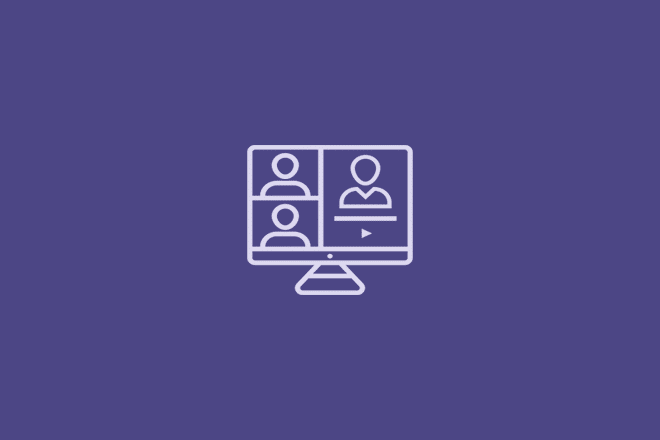
Virtual event design can make or break your online event. There are two major parts of an event design. First, the concepts, programming, and run of show elements that encompass the event itself.
Second, the visual elements that make a virtual event have a presence with the same “feel” as a live conference or session.
Here, we’re going to focus on the design of the latter, so that you can create a branded, consistent theme and package to make virtual events stand out.
Start Design Planning Early
Unlike with traditional live events, you’ll want to think about the design of your virtual stage from Day 1. Connect this concept to the marketing design elements to create a consistent branding design for a virtual event.
Planning a virtual event takes a lot more design time behind the scenes
Yes, this is more work in the early stages. Planning a virtual event takes a lot more design time behind the scenes in the planning phase of an event than for live conferences because design elements are part of the backbone of the design.
Visual consistency is the key to ensuring that someone who signs up for a virtual event knows they are in the right place from the early interest phase through signing up (and getting confirmation emails) to attendance. A design that connects all of these elements provides visual consistency and credibility to the event.
Pro tip: Marketing and “stage” design elements need to be the first step in the process so that they are consistent and you don’t change design themes between the early marketing stages of an event and the live, online production.
Establish a Visual Theme
Every piece of your event design should have a strong visual theme that connects everything associated with the event.
For something that’s totally online, a visual theme is more important than ever because the lack of physical presence requires a strong visual online presence for connection.
You’ll want to design event materials in the same manner you might approach a full rebranding design with consistent styles and palettes for color, fonts, visual elements such as images or video, user interface elements, backgrounds, and even microcopy.
Design elements for a virtual event include:
- ”Stage” design for the event including backgrounds, name cards for speakers, polls, or other interactive elements
- Event branding that ties in host and/or sponsors
- Promotional backgrounds and materials
- Buttons and calls to action
- Overall event banners
- Speaker or session event banners
- Signups and registration pages
- Email design
- Social and promotional elements
- Badges or awards
- Event agenda or program
- User profile elements for participants
- Speaker or vendor elements for participants
- Hierarchical design elements for keynote or marquee sessions
- Ad design (if needed)
- Crops/styles for images, headshots, and video clips
Pro tip: Consider trendy design elements such as gradients, dark mode design, and TikTok style animation elements.
Create Digestible Chunks for Speakers and Sessions
One of the tricks of creating a successful virtual event is creating a lot of online buzz. The requires designing chunks of content that might appeal to different people in different circles.
This style of “chunk content” also makes it easy for each speaker to share in their networks to help generate more interest
Create digestible chunks of content that highlight your event including blocks for every speaker or session that makes it easy for people to see what they want when they want it. This style of “chunk content” also makes it easy for each speaker to share in their networks to help generate more interest and help the event travel to groups you might not reach otherwise.
When designing these bits of chunk content, think in “cards” or “blocks” that fit the digital world. Design in a shape and size that creates a modular, multi-purpose role such as speaker cards in the standard Facebook size, but put the main content in a center square in the 1200- by 628-pixel block. This makes them shareable on Facebook and easy to crop for Instagram or other square uses.
Now you’ve designed one element that can work on your website or social media and is designed to travel virtually.
Pro tip: Design cards for every speaker and session in shareable social sizes and send the artwork to each speaker with a link for easy sharing.
Skip the Template Platform and Design Your Own
Most online event platforms have a default look to them. Skip using these default templates if you want your event to feel custom.
You need to design each event platform to work with your style. Schedule a nice bit of time for this because many of these platforms allow for complete customization, but a lot of the technology is relatively new and a little clunky at times.
Be ready to create design elements in lots of odd sizes and styles to create a fully customized event platform.
Pro tip: Match to your branding and color palette.
Think About the Details
The small design elements are the things that will make or break your virtual event design at the end of the day.
Create styles and a plan that includes small event elements, such as name badges, speaker profiles, participant profiles, and easy-to-use branding for vendors or sponsors.
Take it a step further with a custom emoji or badge that “lives” outside the event platform. Create a packet of materials that participants, vendors, and speakers can download and share to reinforce event information.
Make sure to use all the same design elements for everything for a completely virtual event user experience.
Pro tip: Design nameplates and session titles for speakers.
Use Consistent Filters and Image Crops
Create a style for imagery for your events, such as a photo filter or crop. This can further reinforce visual identity.
Think about how you’ll gather content to create a style that works best for your event. If you are asking for headshots, for example, they may come in a lot of different looks and styles. You may want to create an image filter, overlay, or stylized crop shape to establish visual consistency.
Pro tip: Create an action or brush in Photoshop to make quick work of these design elements.
Use Gamification with Shareable Badges
Virtual events should be fun! Use design elements with gamification to help participants promote your event.
Design badges or other elements that participants can collect and share during the virtual event to encourage greater participation and generate additional interest in your event online.
Pro tip: Award badges that users want to share on social media as a profile frame on Facebook, LinkedIn “certificate,” or another social card. Connect badges and awards to a points or game system for prizes or swag to encourage participation.
Conclusion
With so many virtual events to choose from, the design of your event online can make or break attendance. The look and feel of the event itself can make it feel like it is worth the price of admission. It can take plenty of careful planning to ensure that an online event has the same stage presence and feel like a live event.
Admittedly, it’s a different thought process that goes into designing virtual events. It takes a lot more work upfront than spread out across the duration of the event. Design choices that you make early on will live with you until event day.












